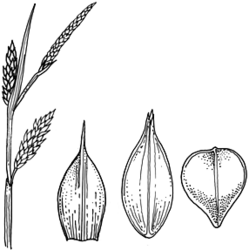Carex blakei Nelmes APNI* 
Description: Rhizome long; shoots ± densely tufted. Culms mostly enclosed in leaf sheaths, much shorter than inflorescence, erect, trigonous, smooth or scabrous, 2–10 cm long, 1–2 mm diam.
Leaves usually shorter than inflorescence; blade 4–6 mm wide; sheath yellow-brown to red-brown; ligule truncate or rounded.
Inflorescence erect, narrow, 8–35 cm long, with 3–6 spikes solitary at nodes, with very long internode between the lowest and next node; involucral bracts of upper nodes exceeding inflorescence but lowest bract shorter than inflorescence. Spikes sessile, upper contiguous, lower very distant, spreading to erect at maturity, 1–2.5 cm long; uppermost spike (rarely 2 or 3) male; lower spikes female. Glumes obtuse to retuse, erose, shortly mucronate, pale brown tinged red-brown, to evenly dark red-brown; female glumes c. 3 mm long. Perigynia (utricles) ellipsoid, faintly numerous-nerved, 3.3–4.0 mmlong, 1.4–2 mm diam., often minutely hispid on shoulders and beak, pale brown, red-dotted; beak 0.5–0.8 mm long, with apex 2-fid to notched. Anthers 2.5–2.8 mm long excluding appendage to 0.1 mm long. Anthers 2.5–2.8 mm long excluding appendage to 0.1 mm long. Style 3-fid.
Nut obovoid, trigonous in cross section, dark yellow-brown.
Flowering: summer.
Distribution and occurrence: Tablelands south from Brindabella Range into Victoria. Grows in or near swamps, especially sphagnum bog areas at high elevation.
NSW subdivisions: ST
Other Australian states: Vic.
Text by K. L. Wilson (1993); edited KL Wilson (July 2016)
Taxon concept: Flora of NSW 4 (1993)
APNI* Provides a link to the Australian Plant Name Index (hosted by the Australian National Botanic Gardens) for comprehensive bibliographic data
***The AVH map option provides a detailed interactive Australia wide distribution map drawn from collections held by all major Australian herbaria participating in the Australian Virtual Herbarium project.
|


